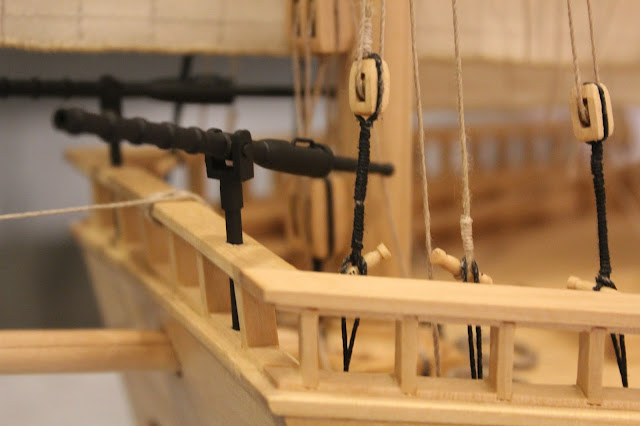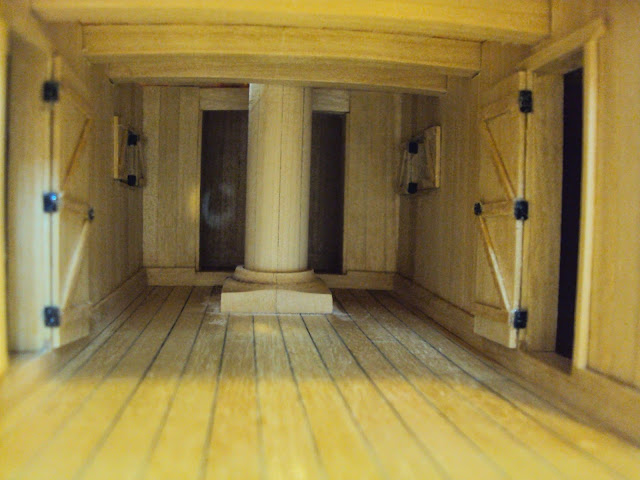Portuguese Caravel from the XV - Scale 1/30
The caravela is the most famous of the sea going Portuguese ships.
She sailed from the end of the 15th century until the mid-17th century.
She was fast and strongly built. Caravels had latin sails in two or three masts, between 20 and 30 metres long and 50 to 80 tons burden.
This is a replica of “Bérrio”, a caravel from Vasco da Gama’s fleet, on his first trip to India. She sailed from Lisbon on 8 July 1497 and returned on 10 July 1499 with the news of the discovery of the India Route.
Birch wood construction on a maritime plywood structure, wooden masts and yards rigging in linen, sails in canvas, artillery in metal.
Scale 1/30 museum standard ship model, with 1,10 meters long and 0,90 metres high.
It took me around one year of full time work to complete this model, which has been commissioned by the Portuguese Fundação Calouste Gulbenkian to be donated to the National Museum of Oman.
The model is currently on display at the “Oman and the World Gallery”, National Museum of Oman, Muscat, Sultanate of Oman.

The caravela is the most famous of the sea going Portuguese ships.
She sailed from the end of the 15th century until the mid-17th century.
She was fast and strongly built. Caravels had latin sails in two or three masts, between 20 and 30 metres long and 50 to 80 tons burden.
This is a replica of “Bérrio”, a caravel from Vasco da Gama’s fleet, on his first trip to India. She sailed from Lisbon on 8 July 1497 and returned on 10 July 1499 with the news of the discovery of the India Route.
Birch wood construction on a maritime plywood structure, wooden masts and yards rigging in linen, sails in canvas, artillery in metal.
Scale 1/30 museum standard ship model, with 1,10 meters long and 0,90 metres high.
It took me around one year of full time work to complete this model, which has been commissioned by the Portuguese Fundação Calouste Gulbenkian to be donated to the National Museum of Oman.
The model is currently on display at the “Oman and the World Gallery”, National Museum of Oman, Muscat, Sultanate of Oman.

Caravela Portuguese do Século XV
A caravela é a mais famosa de todas as embarcações portuguesas. Foi utilizada pelos navegadores portugueses desde o final do século XV até meados do século XVII. Caracteriza-se por ser um navio robusto e veloz, com velas latinas em dois ou três mastros. As caravelas tinham entre 20 a 30 metros de comprimento e 50 a 80 toneladas de porte.
A caravela é a mais famosa de todas as embarcações portuguesas. Foi utilizada pelos navegadores portugueses desde o final do século XV até meados do século XVII. Caracteriza-se por ser um navio robusto e veloz, com velas latinas em dois ou três mastros. As caravelas tinham entre 20 a 30 metros de comprimento e 50 a 80 toneladas de porte.
O modelo de caravela a construir pretende recriar a caravela Bérrio, que fez parte da armada de Vasco da Gama na viagem inaugural à Índia. Zarpou de Lisboa a 8 de Julho de 1497 e regressou a 10 de Julho de 1499 com a notícia da descoberta do Caminho Marítimo para a Índia.
O projecto tem por base o modelo de caravela latina com três mastros em exposição no Museu de Marinha, em Lisboa, mas incorpora os resultados das investigações mais recentes e constitui uma oportunidade para proceder a uma revisão científica sobre a matéria.
Construção em madeira de bétula sobre uma estrutura de contraplacado marítimo.
Casco e convés com duas camadas de madeira de bétula, mastros e vergas em madeira, aparelho fixo e de laborar em linho e velas em tela. Batel em madeira, artilharia em metal. O modelo não será pintado, mas envernizado para realçar o trabalho realizado e pôr em evidências as técnicas de colocação dos forros de costado e cobertas.
Dimensões do modelo (aprox.)
Escala: 1/30
Comprimento total: 1,10 metros
Altura total com aparelho: 0.90 metros
Boca: 0,30 metros











